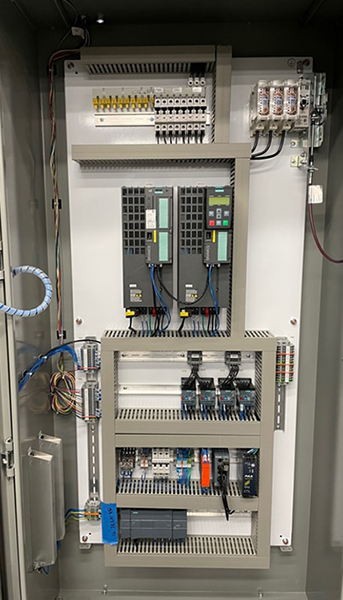Controls

Controls
Warehouse controls systems translate data into machine language, allowing hardware to perform the right actions at the right times to maximize throughput.
Material handling controls are the software, hardware, sensors, and communications systems needed for equipment to operate properly. Controls can also monitor and verify the proper functioning of equipment, as well as identify goods and track their movement.
Human-Machine Interfaces (HMIs) connect operators with automated systems. While they can be as simple as an on-off switch, modern HMIs are sophisticated enough to allow real-time, user-friendly, graphical feedback and control of processes and equipment to maximize operational uptime.
Components of a controls system.
Depending on the equipment and the scope of the application, systems controls include:
- Sensors that detect the presence or condition of an object in a field, such as optical sensors, limit switches, and magnetic or ultrasonic proximity systems.
- Smart hardware that both collect and process information about equipment or inventory, such as RFID detectors, weight scales, and barcode readers and scanners.
- Safety features that prevent operation if an operator enters a prohibited space, such as kill switches, interlock devices, and guarding.
- Software that enables the proper functioning of various controller components by accepting inputs, processing data, and sending outputs.
- Communication devices including the wiring between components, wireless interfaces, networking devices, and Human-Machine Interfacing (HMI).
Material handling controls bring true integration between your systems.
Material handling controls govern the motors, sensors, switches, and other devices that allow individual devices to function optimally and safely. Equipment that stops at a set pressure, that turns on at a set time, that rotates product a number of degrees, that moves at a set speed, or that turns off if a safety barrier is crossed, are all operated with controls.
Controls solutions also enable different equipment from different manufacturers to work together seamlessly. An automated conveyor that feeds into a robotic palletizer, or a Vertical Lift Module that interacts with shuttles, need proper controls in order to maintain the right sequencing.
Controls solutions offer key benefits to your facility.
Whether you’re working with automated storage and retrieval systems (AS/RSs), conveyors, or carousels, you need the right controls system to produce measurable improvements and benefits.
- Optimization of individual equipment. Controls systems interface with and manage the motors, sensors, and other hardware components that are foundational to your system.
- Proper sequencing of systems and processes. Controls enable communication between, and proper sequencing of, the many different components of your system.
- Improved safety due to equipment optimization. Control systems both operate the sensors and switches that make machines safe to work around, while also keeping the equipment working optimally.
- Better inventory control. Controls enable equipment to move product properly throughout the system, handling orientation, speed, and routing, while also relaying that information to the HMI.
- Real time visibility, monitoring, and updates. Controls monitor and diagnose equipment performance in real time, identifying issues and informing operators so that problems can be addressed quickly.
- Continuous improvement. With the data and insights taken from the feedback provided by warehouse control solutions, facilities can identify their pain points and bottlenecks, and better plan for growth.